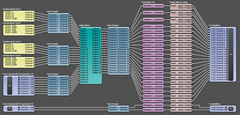Audio Architect in multi-use theater applications
 Multi-use theater systems have a number of unique requirements, including:
Multi-use theater systems have a number of unique requirements, including:
● Audio from mixing console and multimedia sources
● Bi-amplified Left, Center and Right speaker arrays
● Multiple outputs for surround speakers (side and rear)
● Independent gain, EQ, delay and limiting for each output
● Master gain control for each multimedia source
Many of today’s theaters are designed to support live presentations in addition to multimedia playback. Soundweb London can easily handle complex routing of a variety of signal formats.
In this application the Soundcraft Si Expression 16 digital console with a BLU link output card provides multiple channels of audio via BLU link to a BLU-160. Additionally there are two multi-output DVD players connected to the BLU-160 via analog inputs. These signals feed a matrix mixer were they can be easily routed by means of parameter presets.
JBL PD5322/95 function as the main screen speakers. These are three-way speakers being used in their passive bi-amplified mode. Several of the outputs on the multi-channel Crown Drive Core Install DCi amplifiers are bridged, as needed, to supply appropriate power to the dual 12” low frequency drivers in the JBL PD5322/95 speakers. The Soundweb London Crossover can be scaled to provide up to six bands of output providing enough flexibility for any multi-component speaker cluster. The Crossover provides control over limiting, delay, gain and frequency for each of the outputs allowing the installer to tune the speaker clusters for their best performance within the space.
In this design, ten bands of parametric EQ are provided for each of the 18 system outputs. These filters can be reallocated within the design simply by changing the properties of the processing object to increase or decrease the number of filters needed for any given path of processing.
Although the surround outputs are full range JBL SCS8 speakers, by using a single band Crossover set to “full-range”, delay, gain and limiting are available from one processing object for each of the surround outputs. By providing discreet outputs for each of the surround speakers and sub woofers, the installer can fine tune the delay, gain, and filters per speaker to create the optimum acoustical environment and the end user can be prepared for future surround sound formats.
Utilizing the scalable Gain N-Input object to create a six channel gain block allows the user to adjust the multi-channel signals of the multimedia sources from a single master gain fader. These gain controls, as well as the matrix routing parameter preset recalls, can all be easily accessed by the operator from an Apple iOS device via the HiQnet Motion Control app, integrated into a presentation lectern, projection booth or mix location equipment rack.
 The Multi-Use Theater system DSP diagram is very straightforward. Generally DVD player and console outputs are routed to the cinema playback speakers utilizing a 7.1 standard routing - Left, Center, Right, Low Frequency Effects, Surround Side Left, Surround Side Right, Surround Rear Left and Surround Rear Right. All of this routing can be set and modified through the use of the central Matrix Mixer. If needed, discrete sends from the console to the JBL SCS8 surround speakers could be used for special effects, for example.
The Multi-Use Theater system DSP diagram is very straightforward. Generally DVD player and console outputs are routed to the cinema playback speakers utilizing a 7.1 standard routing - Left, Center, Right, Low Frequency Effects, Surround Side Left, Surround Side Right, Surround Rear Left and Surround Rear Right. All of this routing can be set and modified through the use of the central Matrix Mixer. If needed, discrete sends from the console to the JBL SCS8 surround speakers could be used for special effects, for example.
In addition, two console output channels are hard-routed (Matrix bypassed) to the two JBL CBT 70J speakers at the front of the auditorium primarily dedicated for speech reinforcement or small music ensembles.
Gain N-Input processing objects are provided for each input to adjust for level gain on the input of the Matrix Mixer. As noted above, output processing is provided by 10-filter Parametric EQ and Delay, Gain and Limiter processing objects are all contained within the output filter processors.
